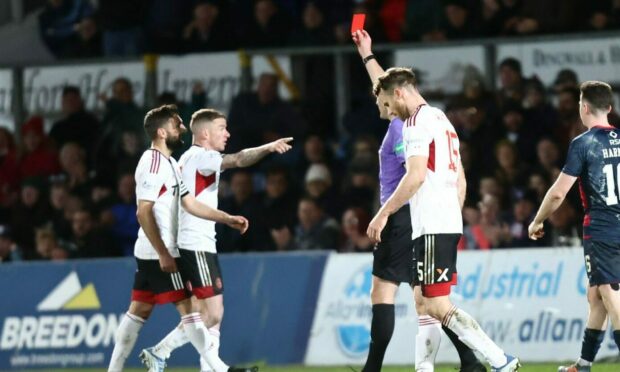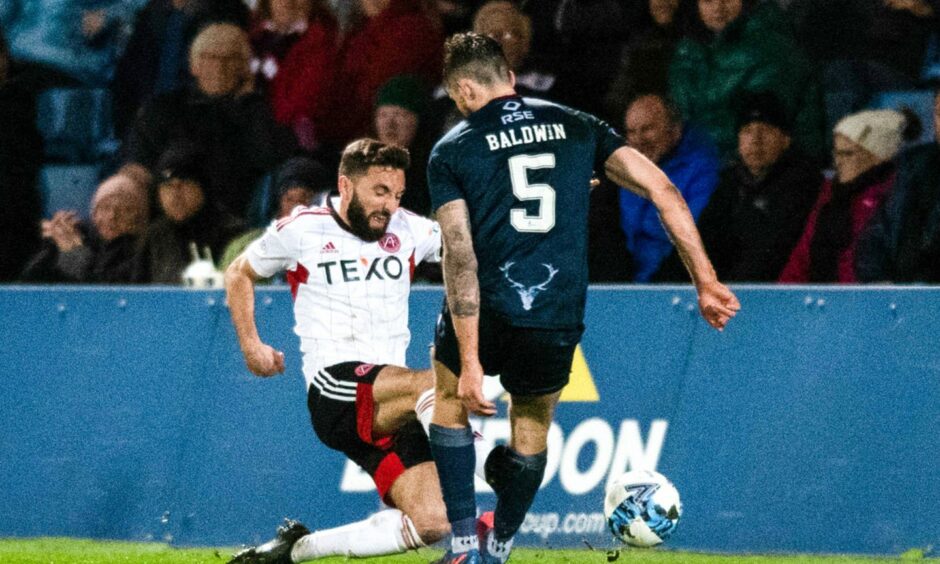Aberdeen celebrated their 120th birthday with a 1-0 win at Ross County which ultimately strengthened their grip on third in the Premiership.
However, the victory in Dingwall, courtesy of Luis “Duk” Lopes’ 18th goal of the season, wasn’t without refereeing controversy.
Below, our expert Finlay Elder gives his view on the performances of referee Euan Anderson and his supporting cast of officials – including how VAR had a bearing on proceedings.
How did he rate the officiating at the Global Energy Stadium?
Early handball calls were correct
We started off with a handball shout from Ross County, after a couple of shots heading towards the goal were blocked by Aberdeen defenders.
The actual VAR check for handball, which looked at Angus MacDonald’s block, was most definitely not a handball – but given the continued inconsistency with regards these type of incidents since the introduction of VAR, you can never be sure.
The arm of the defender was close to his body and not in an unnatural position, and therefore, no penalty was the correct decision.
What’s the point in having VAR, if we aren’t going to have the right camera angles?
Aberdeen took the lead through a well-worked Duk goal, with no issues from a refereeing standpoint.
However, Aberdeen thought they had scored a second goal of the game after the interval when Bojan Miovski slotted past Ross Laidlaw early in the second half.
But the goal was ruled out after Duk was deemed to be offside in the build-up.
Initially, I thought Duk was offside, but, upon seeing the replay, I thought he was just in line with the last defender.
VAR – which is there in-part to review these tight offside calls – took plenty of time to look at the one angle they had of Duk’s run.
And it was pretty poor to see VAR being so restricted in the camera angles they have for such a marginal call.
After the lines were drawn, I was still unconvinced Duk was offside – and I think it would be hard for anyone to say, definitively, looking at that angle, where exactly he was in relation to the last defender.
Offside had been given, though, and VAR ultimately backed up the on-field call.
It does beg the question, though, of what is the point of VAR if there are not the facilities to accommodate it (in terms of cameras)?
With a call being that tight, having only one angle is ridiculous.
❌ Aberdeen had the ball in the net again but Miovski's goal was ruled out for offside!
Who will grab the next goal?🔽 pic.twitter.com/CmRXKsR55i
— Sky Sports Scotland (@ScotlandSky) April 14, 2023
In English games, where there are always a multitude of angles, I have seen calls look offside, but then clearly onside from another angle.
The best angle to call offside is a view right along the line, and it is disappointing to not see that angle be available to VAR.
According to common sense, Shinnie shouldn’t have been sent off
Aberdeen captain Graeme Shinnie was making his 200th appearance for the Dons on Friday, and unfortunately for him it would end with a red card.
My first reaction was Shinnie’s 50/50 challenge with Ross County’s Jack Baldwin was a great tackle, and he clearly won the ball.
However, on the review, you could see contact was made on the County player as Shinnie followed through after the challenge.
I don’t think it is a red card – I think it’s a 50/50, with both players going in for the ball.
Both players were fully committed, but Shinnie got their first.
And it is worth noting Baldwin also caught Shinnie in the challenge.
The big question for me is what is Shinnie actually meant to do.
He has got to go in to win the ball. He wins it cleanly and you could see on the footage he then attempted to pull out after he had won the ball. But where is his foot meant to go?
Unfortunately, though, despite all of the common-sense applied above, in this day and age of football, with the rules as they are, it is a red card.
And when you have the use of VAR and look at something in slow motion like that, officials are going to give it every day of the week.
I do think Shinnie was incredibly unlucky, as I don’t think there is any malice in the challenge.
He was going into a 50/50, won the ball, and both players made contact with each other going for the ball. Shinnie was just the unfortunate one who made contact after the challenge first.
🔴RED CARD!
Graeme Shinnie is sent off for Aberdeen after a VAR check. Correct call?🔽 pic.twitter.com/9A1DphuLGG
— Sky Sports Scotland (@ScotlandSky) April 14, 2023
- Finlay Elder has been a registered referee for six years and a category 5 official since 2019, with experience in the Highland League, juniors and Club Academy.



Conversation